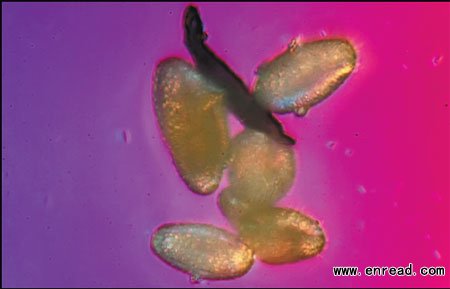| ||||||||||||||||||||||||||||||||||||||||||||||||||||||||||||||||||||||||||||||||||||||||||||||||
|
It has been two years since China Daily last interviewed 31-year-old Zhang Chao. The Beijing-based micrograph enthusiast1 still wears the same hair style, even the same coat.
中国日报两年之前曾经采访过31岁的摄影师张超。如今,这个北京显微摄影的狂热爱好者依然留着同样的发型,甚至穿着同样的衣服。
 A picture of smog particles under the microscope taken by Zhang Chao But one thing is very different: He's become a celebrity2 in cyberspace3 almost overnight, after his pictures, which depict4 what the rampant5(蔓延的) smog in Beijing looks like under his microscope, spread like a virus on China's major micro-blogging site Sina Weibo, since he posted them last Friday. Now the media is hounding him for interviews.
"Why do I become famous when I took pictures of the smog?" he asks with a wry6 smile. "I have taken numerous pictures of beautiful nature whenever I have spare time, but there are no more than 10 interview requests for me every year before. Now, I have to answer dozens of phone calls from media every day.
"But I only gained 2,000 more followers7 over the weekend. I guess the micro blog is not as popular as before," he says, jokingly.
On Monday morning, a camera crew from a TV station based in southern Hunan province even took a flight to Beijing just to record how Zhang takes pictures of the Beijing's most-talked about feature: the floating enemies in the air.
The process is not complicated: He puts microscope slides on his windowsill(窗台) and collects the samples covered by fallen dust after 10 hours.
Zhang's apartment is on the eighth floor, which he says is perfect for capturing the densest8 levels of smog.
As a Beijing native, Zhang explains his original purpose is to "deconstruct" Beijing's smog and unveil its shroud9 of mystery.
"People have higher and higher standards for the environment," he says. "When I was a child, I was annoyed by the frequent sandstorms, so I feel Beijing's air seems much better now all in all because there are hardly any sandstorms in recent years. Now, we've noticed PM2.5, which has long been neglected."
Although he graduated as a science major from Beijing Normal University, Zhang says it is difficult for him to give an exact definition of what smog is in Beijing. "It's too complicated, and its ingredients keep changing."
Under his scope, which magnifies the sample 1,000 times, the smog is found to contain minerals, fragments of animal fur and insects, seeds and burnt dust. But many are compounds, he says, which are more difficult to identify.
"I wanted to know if there are many pollen10 grains in the early spring's smog, and my guess turns out to be right," Zhang says, noting there are on average 10 pollen grains found on each slide.
点击  收听单词发音 收听单词发音
|
||||||||||||||||||||||||||||||||||||||||||||||||||||||||||||||||||||||||||||||||||||||||||||||||
上一篇:可以延缓衰老的六种食物 下一篇:抑郁是引发身心障碍的第二大原因 |
||||||||||||||||||||||||||||||||||||||||||||||||||||||||||||||||||||||||||||||||||||||||||||||||
- 发表评论
-
- 最新评论 进入详细评论页>>



